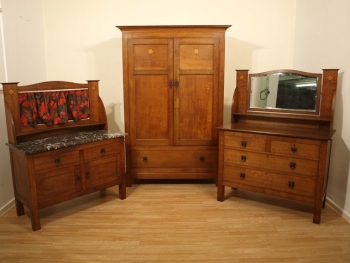Tips on Understanding Antique Furniture

Buying antique furniture can be a baffling, if rewarding experience, full of quaint spellings, misnomers and confusing names. Understanding what these mean will place the piece into its social context, taking the owner on a fascinating trip back in time.
Many antique furniture definitions are modern. Today, auctioneers and dealers go to great lengths to describe fittings, but in the 18th Century there was no differentiation made between, for example, different handle styles; often, they were only identified by a catalogue number. Manufacturers began naming their products in the 19th Century, when things got more competitive.
Tips on understanding Victorian furniture
While the Victorians were good at naming things, they were good at misnaming them too. A good example is the Grandfather clock, or the smaller, rarer, Grandmother clock. No antique dealer would use this term – both are longcase clocks – but the uninitiated are still more familiar with the name inspired by a famous old music hall song.
The mid-Victorian period saw an explosion of interest in the past, with many English oak pieces produced. Oak antique furniture is surprisingly rich in misnomers, which might have originated from dealers keen to summon up images of a more romantic past or make things appear older than they were.
Ye Olde Antique Furniture Shoppe
The joint stool, a rustic backless chair dating from the 15th Century, was simply listed as a stool in contemporary literature, but these days the full description is used. In old documents joint is often spelt as joyn’d, but both describe the way the chair is constructed. Incidentally, the term Coffin Stool came into vogue during the 1900s, inspired by a passage in the Samuel Pepys Diary, which first appeared in the late Victorian period. A back stool, incidentally, is another term for a simple rustic dining chair.
Another misnomer is the bible box, which is no different to any other oak box. While some were no doubt used to house the family bible, this was not their primary purpose. They were more likely to be used as sewing boxes.
Tips about tables
Anyone familiar with antique dining furniture inventory will have seen gate-leg tables, although the name itself is fairly modern. The correct period description is drop-leaf or falling-leaf table, as described in a 17th century inventory for Tart Hall. Drop-leaf is still in common use today, although not all drop-leafs are gate-legs.
The refectory table is one item of antique furniture that definitely sums up visions of a romantic past, one of mediaeval knights and chanting monks. However, this type of large, solid table remained in vogue long after the dissolution of the monasteries, while the Monks’ Bench is entirely spurious.
Fold-away chair advice
Often, certain people or places achieve fame through furniture. The Savonarola Chair is a folding X-framed device named after a notorious 14th century monk who owned one. Yet the chair itself was common in Ancient Egypt and Rome. Likewise, the Glastonbury Chair is not unique to Glastonbury, or the Windsor chair to Windsor, come to that.
Many people buy antique furniture simply because they like the look of the thing, but it is so much more interesting to know the back-story.
